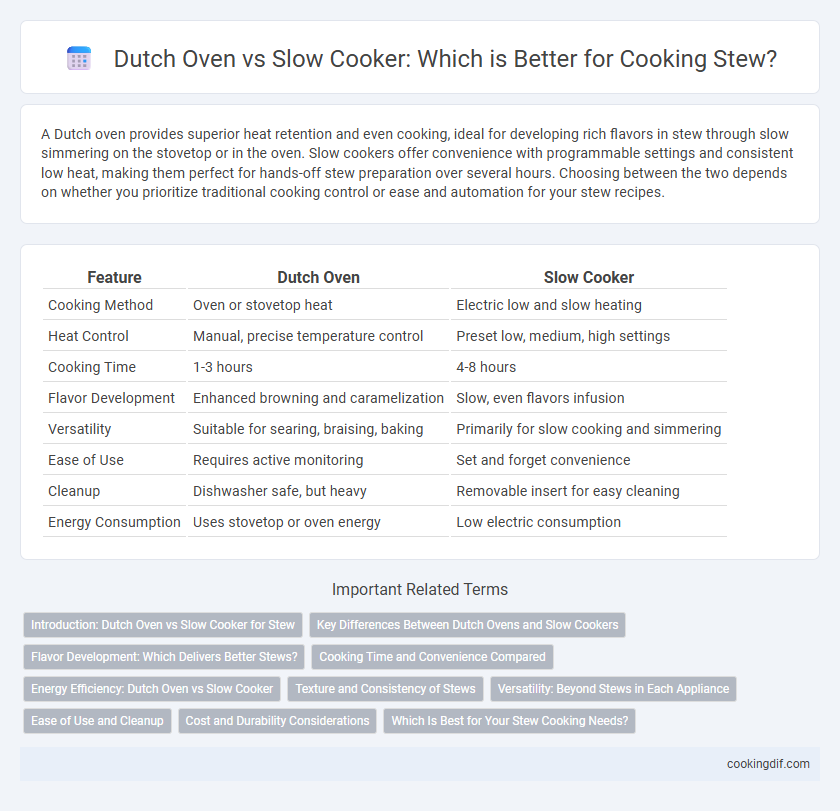A Dutch oven provides superior heat retention and even cooking, ideal for developing rich flavors in stew through slow simmering on the stovetop or in the oven. Slow cookers offer convenience with programmable settings and consistent low heat, making them perfect for hands-off stew preparation over several hours. Choosing between the two depends on whether you prioritize traditional cooking control or ease and automation for your stew recipes.
Table of Comparison
| Feature | Dutch Oven | Slow Cooker |
|---|---|---|
| Cooking Method | Oven or stovetop heat | Electric low and slow heating |
| Heat Control | Manual, precise temperature control | Preset low, medium, high settings |
| Cooking Time | 1-3 hours | 4-8 hours |
| Flavor Development | Enhanced browning and caramelization | Slow, even flavors infusion |
| Versatility | Suitable for searing, braising, baking | Primarily for slow cooking and simmering |
| Ease of Use | Requires active monitoring | Set and forget convenience |
| Cleanup | Dishwasher safe, but heavy | Removable insert for easy cleaning |
| Energy Consumption | Uses stovetop or oven energy | Low electric consumption |
Introduction: Dutch Oven vs Slow Cooker for Stew
Dutch ovens provide superior heat retention and even cooking, making them ideal for developing rich, caramelized flavors in stew through stovetop or oven use. Slow cookers maintain a consistent low temperature over extended periods, ensuring tender meat and melded spices with minimal supervision. Both tools excel at stew preparation, but Dutch ovens offer greater versatility and a traditional cooking experience.
Key Differences Between Dutch Ovens and Slow Cookers
Dutch ovens offer superior heat retention and even cooking due to their heavy cast iron construction, making them ideal for stovetop searing and oven use in stew preparation. Slow cookers provide consistent low-temperature cooking with programmable timers, enabling hands-off cooking and convenience for long, slow stewing without monitoring. The main differences lie in temperature control, cooking methods, and maintenance, with Dutch ovens requiring manual heat management and slow cookers emphasizing automation and energy efficiency.
Flavor Development: Which Delivers Better Stews?
Dutch ovens excel at flavor development in stew cooking through their ability to maintain consistent, high heat and promote Maillard browning, which enhances the depth and complexity of flavors. Slow cookers, while convenient for long, low-temperature cooking, often produce milder stews with less pronounced caramelization and savory richness. The sealed environment and stovetop or oven heat of a Dutch oven allow for better evaporation control and concentrated taste, making it the preferred choice for richly flavored stews.
Cooking Time and Convenience Compared
Dutch ovens offer faster cooking times due to direct stovetop-to-oven heat distribution, typically reducing stew preparation to 2-3 hours. Slow cookers excel in convenience by allowing unattended cooking over 6-8 hours with consistent low heat, ideal for busy schedules. Both devices retain moisture effectively, but slow cookers provide automatic temperature control, minimizing the need for monitoring.
Energy Efficiency: Dutch Oven vs Slow Cooker
Dutch ovens excel in heat retention and can cook stews efficiently on low stovetop settings or in the oven, using less continuous energy due to their heavy cast iron construction. Slow cookers consume electricity throughout the entire cooking process, typically between 70 to 250 watts, which can lead to higher energy usage over extended periods. For long, unattended cooking sessions, slow cookers offer convenience, but Dutch ovens can be more energy-efficient when stove or oven heat is used minimally and the pot's thermal mass maintains steady cooking temperatures.
Texture and Consistency of Stews
Dutch ovens create stews with a rich, thick texture by allowing even heat distribution and moisture retention through slow simmering, resulting in tender meat and well-integrated flavors. Slow cookers maintain a consistent low temperature for extended periods, producing uniformly soft ingredients but sometimes yielding a more watery consistency due to less evaporation. The Dutch oven's ability to caramelize ingredients at higher oven temperatures enhances stew thickness and depth, while slow cookers excel in convenience with steady, gentle cooking ideal for long braises.
Versatility: Beyond Stews in Each Appliance
The Dutch oven excels in versatility by enabling searing, sauteing, and baking alongside slow simmering, which enriches stews with deep, layered flavors. Slow cookers offer programmable settings that allow unattended cooking of diverse meals, including soups, sauces, and even desserts, with consistent temperature control. Both appliances expand beyond basic stew preparation, catering to various cooking techniques and meal types for diverse culinary needs.
Ease of Use and Cleanup
Dutch ovens offer a straightforward cooking experience with manual temperature control and easy stovetop searing, but they require careful cleaning due to seasoning maintenance. Slow cookers provide a set-it-and-forget-it approach with simple digital controls and removable ceramic inserts, allowing effortless cleanup. The ceramic inserts in slow cookers are typically dishwasher-safe, significantly reducing cleaning time compared to the more hands-on care needed for seasoned cast iron Dutch ovens.
Cost and Durability Considerations
Dutch ovens, typically made of cast iron, offer exceptional durability with the potential to last a lifetime, making them a cost-effective investment despite a higher initial price. Slow cookers generally have a lower upfront cost but may require replacement every few years due to electronic or heating component wear. Choosing between a Dutch oven and a slow cooker for stew often hinges on balancing long-term durability against initial affordability.
Which Is Best for Your Stew Cooking Needs?
A Dutch oven offers superior heat retention and even cooking, making it ideal for developing rich, deeply flavored stews through stovetop or oven use. Slow cookers provide convenience and consistent low-temperature cooking, perfect for tenderizing tougher cuts of meat over several hours with minimal supervision. Choosing the best option depends on your desired cooking method, time availability, and preference for texture and flavor depth in your stew.
Dutch oven vs slow cooker for stew cooking Infographic

 cookingdif.com
cookingdif.com